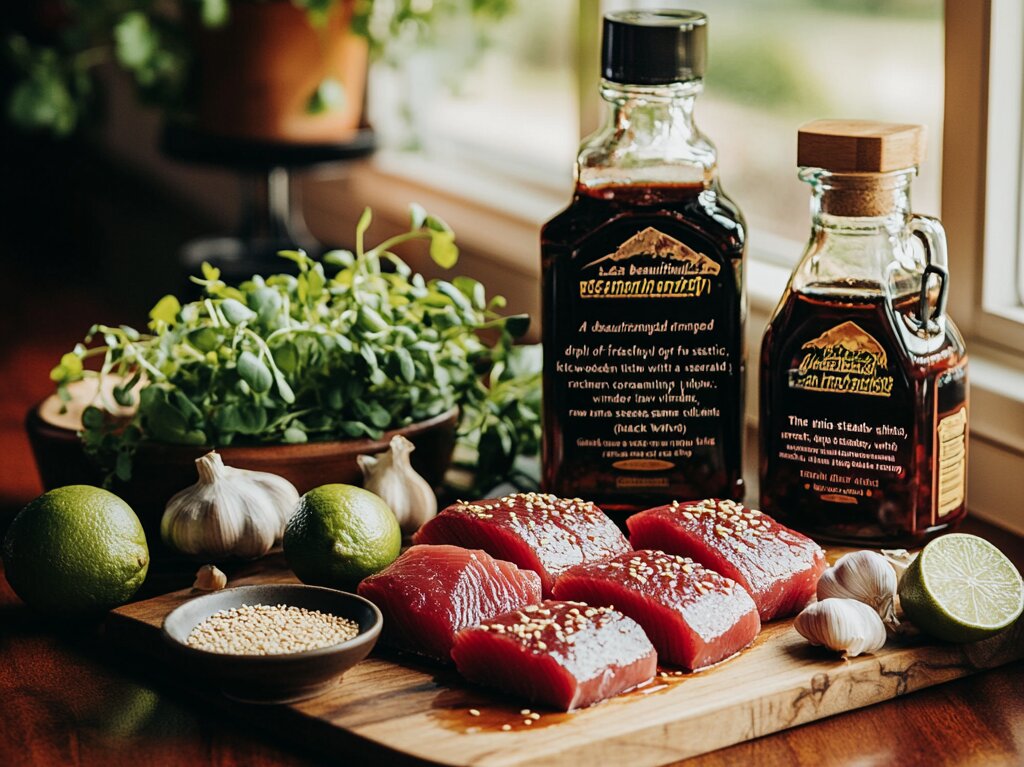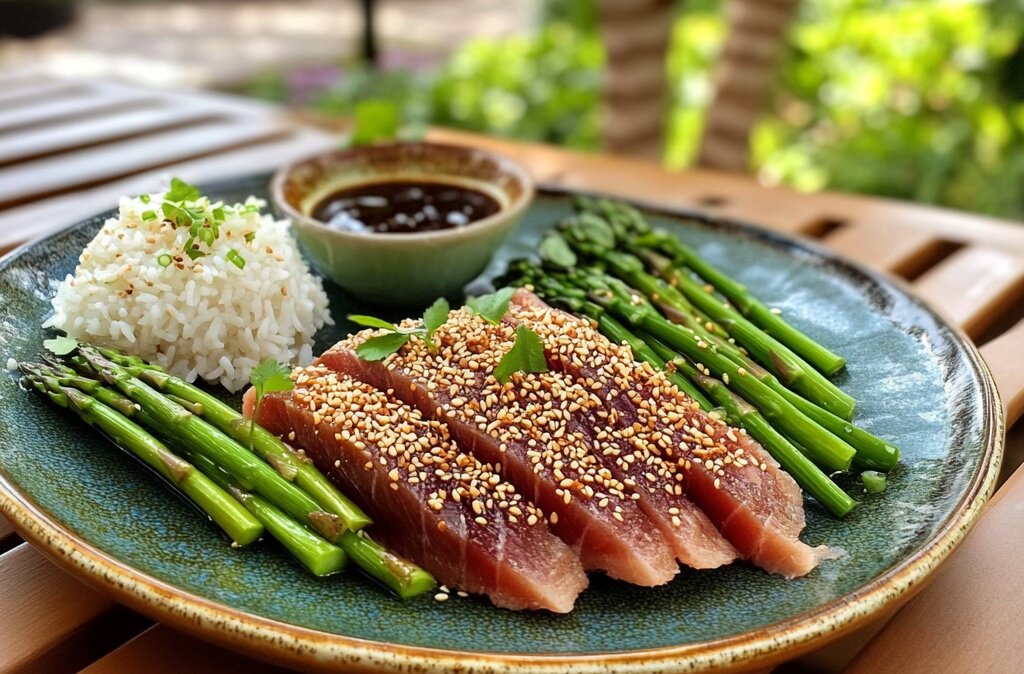Part 1: Introduction and Overview
1. Introduction to Seared Ahi Tuna Recipe
If you’re looking for a dish that’s both elegant and easy to prepare, seared ahi tuna is a top contender. This restaurant-quality recipe combines simplicity with sophistication, offering tender, flavorful fish encased in a crispy, golden crust. Whether you’re a seafood lover or new to cooking fish, this dish is a game-changer.
2. What is Ahi Tuna? A Culinary Perspective
Ahi tuna, also known as yellowfin tuna, is prized for its tender texture and mild flavor. This versatile fish is often served raw in sushi or lightly seared to enhance its natural taste. Its meaty consistency makes it a favorite among chefs for searing, as it holds its structure during high-heat cooking. Learn more about ahi tuna’s culinary versatility here.
3. Health Benefits of Ahi Tuna
Packed with lean protein, omega-3 fatty acids, and essential nutrients like vitamin D and selenium, ahi tuna is a nutritional powerhouse. It supports heart health, boosts brain function, and helps maintain muscle mass. Its low calorie count makes it a perfect choice for health-conscious eaters. Enjoying ahi tuna as part of a balanced diet can be as delicious as it is nourishing.
4. Choosing the Right Tuna for Seared Recipes
When preparing seared ahi tuna, selecting high-quality fish is crucial. Look for sushi-grade or sashimi-grade tuna to ensure freshness and safety for rare consumption. The fish should have a vibrant red or pink hue, firm texture, and no fishy odor. Local seafood markets or trusted online suppliers are excellent sources for premium ahi tuna.
5. Essential Ingredients for Seared Ahi Tuna
The beauty of this dish lies in its simplicity. Here’s what you’ll need:
- Fresh ahi tuna steaks (sushi-grade)
- Soy sauce or tamari for a gluten-free option
- Sesame oil for rich, nutty undertones
- Black and white sesame seeds for texture
- Freshly ground black pepper and sea salt
- Optional: ginger, garlic, or wasabi for added flavor complexity
6. Understanding the Science of Searing
Searing creates a flavorful crust through the Maillard reaction, a chemical process that occurs when proteins and sugars are exposed to high heat. For ahi tuna, the goal is to achieve a quick sear on the outside while keeping the inside tender and rare. This contrast in texture and temperature is what makes seared tuna a culinary delight.

7. Prepping the Ahi Tuna for Cooking
Preparation begins with cleaning and patting the fish dry to ensure a good sear. Slice the tuna into uniform portions for even cooking. Brush each piece with a light coating of oil and season generously to build a flavorful crust.
8. Seasoning Options: Classic vs. Creative
- Classic: A simple combination of sea salt, black pepper, and sesame seeds lets the natural flavor of ahi tuna shine.
- Creative: Experiment with spice blends like Cajun seasoning, za’atar, or a crust of crushed nuts and herbs to add unique layers of flavor.
9. Pan Selection and Importance of High Heat
A heavy-bottomed cast iron skillet or a stainless steel pan works best for achieving a high, even heat. Preheat the pan thoroughly to avoid sticking and to ensure the tuna sears instantly upon contact.
10. Ahi Tuna Pairings: Side Dishes to Elevate the Meal
Complement your seared ahi tuna with sides that balance its richness:
- Vegetables: Steamed asparagus, sautéed spinach, or a crisp green salad.
- Grains: Fluffy jasmine rice or creamy polenta.
- Sauces: Ponzu, soy-ginger glaze, or a bright citrus vinaigrette for acidity.
Part 2: Step-by-Step Recipe Instructions
1. Preparing the Tuna: Cleaning and Portioning
Begin by rinsing the ahi tuna steaks under cold water to remove any residual scales or impurities. Pat them completely dry with a paper towel. Portion the tuna into even, rectangular cuts about 1–1.5 inches thick for uniform cooking. Drying and uniform cuts ensure the best sear.
2. Creating the Perfect Marinade
A marinade enhances the natural flavors of ahi tuna while adding a subtle depth. Here’s a quick marinade recipe:
- 2 tablespoons soy sauce or tamari
- 1 tablespoon sesame oil
- 1 teaspoon grated fresh ginger
- 1 teaspoon minced garlic
- A squeeze of fresh lime juice Whisk the ingredients together and pour over the tuna steaks. Allow the fish to marinate for 15–20 minutes. Avoid longer marination to prevent overpowering the fish’s delicate flavor.
3. How to Sear Ahi Tuna Properly: A Beginner’s Guide
To achieve a restaurant-quality sear:
- Preheat your pan over high heat until it’s almost smoking.
- Add 1–2 tablespoons of sesame oil or neutral oil with a high smoke point, like avocado oil.
- Carefully lay the tuna steaks into the pan, pressing down lightly to ensure full contact with the surface.
4. Time and Temperature: Getting the Perfect Sear
- Cook Time: Sear each side for 1–1.5 minutes for rare or up to 2 minutes for medium-rare. Overcooking can make the tuna dry and chewy.
- Temperature: The pan should maintain consistent heat. If using a thermometer, the internal temperature should not exceed 120°F for rare tuna.
5. Flipping Techniques for Even Cooking
Use a fish spatula or tongs to gently flip the tuna steaks. Tilt the pan slightly to allow oil to coat the steaks evenly, ensuring a golden crust on all sides.
6. Using a Thermometer for Internal Doneness
While ahi tuna is typically served rare, you can use an instant-read thermometer for precision:
- Rare: 115–120°F
- Medium-Rare: 125–130°F
Avoid higher temperatures to preserve the fish’s natural texture and flavor.
7. Achieving a Golden Crust Without Overcooking
To get that signature crust:
- Coat the tuna steaks in a sesame seed mixture before searing. The seeds toast beautifully in the hot oil, adding crunch and a nutty flavor.
- Ensure the pan is extremely hot, as this quick sear prevents the interior from overcooking.
8. Plating Techniques for a Professional Look
For an impressive presentation:
- Slice the tuna against the grain into thin, even strips.
- Arrange the slices fanned out on a plate, showing the rare interior and golden crust.
- Drizzle with soy sauce or a reduction glaze for added flair.
9. Garnishing Ideas: Microgreens, Sesame Seeds, and More
Garnishes enhance the dish visually and flavorfully:
- Sprinkle with toasted sesame seeds for extra crunch.
- Add a handful of microgreens or thinly sliced scallions for freshness.
- Pair with a wedge of lime or lemon for a pop of brightness.
10. Tips for Cooking Ahi Tuna in Alternative Ways (Grilling, Baking)
While searing is the most popular method, ahi tuna can be prepared in other ways:
- Grilling: Brush the steaks with oil and grill over high heat for 1–2 minutes per side.
- Baking: Coat the fish with sesame oil and bake at 400°F for 10–12 minutes for a medium cook.
Part 3: Advanced Techniques and Variations
1. Experimenting with Spice Blends
While classic salt and pepper work wonders, spice blends elevate your ahi tuna recipe to new culinary heights. Some exciting options include:
- Cajun Seasoning: Adds a smoky, spicy kick.
- Za’atar: A Middle Eastern blend with tangy sumac and earthy thyme.
- Chili Lime Rub: Perfect for adding heat with a citrusy balance.
For even application, lightly press the seasoning onto the tuna steaks before searing.
2. Fusion Recipes: Asian-Inspired Ahi Tuna Sear
Integrate Asian flavors to create a unique twist:
- Soy Ginger Glaze: Combine soy sauce, grated ginger, honey, and sesame oil, and reduce to a thick glaze.
- Spicy Mayo Drizzle: Mix mayo with sriracha and a splash of lime juice.
- Wasabi Crust: Incorporate powdered wasabi into your sesame seed coating for a bold, spicy flavor.
3. Incorporating Citrus Zests and Fruit-Based Sauces
Citrus and fruit-based accents pair beautifully with the richness of ahi tuna. Try these:
- Lemon or Orange Zest: Grate fresh zest over the tuna just before serving.
- Mango Salsa: A vibrant mix of diced mango, red onion, cilantro, and jalapeño.
- Pineapple Reduction: Simmer fresh pineapple juice with honey and a pinch of chili flakes for a tropical glaze.
4. Using Sous Vide for Precision Cooking
For ultimate control over the doneness of your ahi tuna:
- Season the tuna steaks and vacuum-seal them in a bag.
- Set your sous vide to 110°F for rare or 120°F for medium-rare and cook for 30–40 minutes.
- Finish with a quick sear in a hot pan to create the crust.
Sous vide ensures evenly cooked tuna with minimal effort.
5. How to Store Leftover Seared Ahi Tuna
Proper storage preserves the quality of your leftovers:
- Place the cooked tuna in an airtight container.
- Refrigerate for up to 2 days.
- Avoid reheating, as it can overcook the tuna. Instead, enjoy it cold in salads or wraps.
6. Transforming Leftovers into Creative Dishes
Leftover ahi tuna can be repurposed into delicious meals:
- Tuna Salad: Mix with avocado, cherry tomatoes, and a light vinaigrette.
- Tacos: Shred the tuna and top with slaw, guacamole, and salsa.
- Rice Bowl: Add the sliced tuna to a bowl of rice, veggies, and a drizzle of soy sauce.
7. Sustainability: Choosing Eco-Friendly Ahi Tuna Options
To support ocean conservation, opt for sustainably sourced ahi tuna. Look for certifications such as:
- Marine Stewardship Council (MSC): Ensures responsible fishing practices.
- Aquaculture Stewardship Council (ASC): Indicates sustainable farming methods.
- Seafood Watch: Use their guidelines to identify environmentally friendly options.
Sustainably sourced tuna not only tastes better but also protects marine ecosystems.
8. Common Mistakes to Avoid When Cooking Ahi Tuna
- Overcooking: Ahi tuna is best served rare or medium-rare to maintain its tenderness.
- Skipping the Drying Step: Moisture prevents proper searing, leading to a lackluster crust.
- Low Heat: A hot pan is essential for achieving the Maillard reaction.
- Overcrowding the Pan: Cook one or two steaks at a time to avoid steaming instead of searing.
9. FAQs About Seared Ahi Tuna Recipes
Here are answers to common questions about preparing and enjoying seared ahi tuna:
- Can I use frozen tuna for searing?
Yes, but ensure it’s properly thawed and labeled as sushi-grade. - What oil works best for searing?
Sesame oil or any neutral, high smoke point oil like avocado or canola. - How do I know if my tuna is sushi-grade?
Check with your fishmonger or look for packaging labeled as “sushi-grade.” - What’s the best way to cut ahi tuna?
Use a sharp knife to slice against the grain for even, clean cuts. - Can I marinate tuna overnight?
No, as the acids in the marinade can start to “cook” the tuna, altering its texture. - Is seared ahi tuna safe to eat rare?
Yes, if the fish is sushi-grade and handled properly. - Can I cook ahi tuna well-done?
While possible, it may become dry and lose its delicate flavor. - What side dishes pair well with ahi tuna?
Light sides like steamed vegetables, rice, or citrus salads are ideal. - What’s the difference between yellowfin and bigeye tuna?
Yellowfin has a milder flavor and firmer texture, while bigeye is richer and more tender. - Can I freeze leftover seared tuna?
It’s not recommended as freezing can affect the texture.
Looking for more delicious ideas? Don’t stop here! Visit the rest of the articles on Recipes Faster to discover a world of quick, easy, and flavorful recipes. From comforting classics to innovative twists, you’re sure to find something perfect for your next meal.

